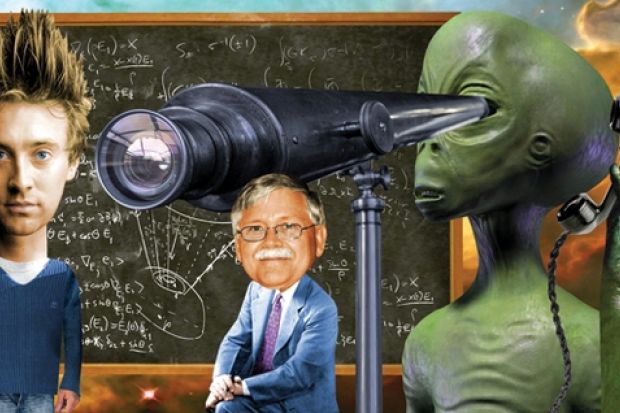Benedict Cumberbatch had better watch out, there's a new set of cheekbones on TV. They belong to Dallas Campbell, presenter of The Search for Life: The Drake Equation (BBC Four, Thursday 5 January, 8pm). Benedict should also look to his curls. Dallas' porcupine hair is not only funky but functional. It bristles out from his head like so many masts primed for a call from E.T.
Dr Frank Drake, who carried out the first modern SETI (search for extraterrestrial intelligence) experiment, has no doubt that, one day, the phone will ring. He has an equation to prove it. If you multiply a lot of variables to do with the rate of star formation, the likelihood of life arising and the ability to send signals into space, then there are about 50,000 civilisations in the Milky Way.
Back in the 1960s, when Frank first crunched the numbers, he was regarded as a crank. But a lot has changed since then. We know a bit more about the cosmos, the origin of life and our own evolution. If we can do it, then surely others can too. Hopefully they will produce something a bit more impressive after millions of years of genetic mutation than Jeremy Clarkson.
Dr Gerald Joyce of the Scripps Research Institute observed, in the rather bored manner of one who spends his working day creating life, that "there are no show-stoppers in how we got from chemistry to biology". The miraculous has become the mundane. You could almost hear the Almighty take a sharp intake of breath.
Where life is, intelligence inevitably follows. So said Professor Nicola Clayton of the University of Cambridge, who has obviously never seen a Steven Seagal film. Instead she has spent her time observing the behaviour of jays. If another bird watches while they hide food, they will return later and move it to a different place. This apparently shows that they have a theory of mind, although not a very good one, as they clearly haven't anticipated the other bird raiding their store as soon as they have flown off. Dr Simon Conway Morris, also from Cambridge, said that, in terms of intelligence, elephants are like we were about 100,000 years ago, meaning, presumably, that they will be soon be wearing necklaces and doing cave paintings. Always supposing we haven't made them extinct first.
Dallas and Frank sat in the Robert C. Byrd radio telescope in Green Bank, West Virginia. It is the world's largest, fully steerable instrument for studying the stars. Dallas was full of hope. Frank was more philosophical. He remembered Carl Sagan eagerly waiting to hear a voice from another world but, after an hour, "he got bored, started to read a newspaper and then nodded off". One reason for the silence is that cosmologists don't know if they are tuning into the frequencies on which advanced civilisations may be transmitting. I sympathise. Some days, I can't even get Radio 4.
The variety of radio waves was illustrated by superimposing different-size Slinkies undulating along a desert road. The emptiness seemed all the greater when they had disappeared. Just scrub and shimmering heat, like the scene of a spaghetti western. I half expected to see a cheroot-smoking Clint Eastwood emerge from the haze, as tight-lipped as the galaxy itself. The best shot of the documentary was the jokey tribute to 2001: A Space Odyssey. Professor Paul Davies threw a stick into the air, which became a satellite.
Stanley Kubrick, the director of the film, was fascinated by long corridors, and they don't come any longer than the Large Hadron Collider (The Hunt for Higgs: A Horizon Special, BBC Two, Monday 9 January, 9pm), built to find the Higgs boson, the particle responsible for giving the other particles their mass.
Dr Michio Kaku, looking more and more like God before he decided to create the Universe, said that the Standard Model, which predicts the existence of the Higgs, contains a contradiction. It shows us that symmetry is the order of nature, but if nature was truly symmetrical, then nothing would exist at all. Jeremy Clarkson is proof that the Universe is unbalanced.
Has physics caught up with Plato? His idea that things are a poor imitation of their ideal forms has become an equation. It's the fate of all the most important metaphors. We are made of the stuff we study, stuff that itself prompts us to give it an ever more precise expression of itself.
Is it a bird? Is it a plane? No, it's Supersymmetry, which solves the hierarchy problem of the Standard Model - for example, that the Higgs is too light - by the invention of new particles called "sparticles". If it's hard to identify the Higgs, it's going to be hell finding one of these. "Which one of you is Sparticle?" "I am Sparticle." "No, I am Sparticle."
Register to continue
Why register?
- Registration is free and only takes a moment
- Once registered, you can read 3 articles a month
- Sign up for our newsletter
Subscribe
Or subscribe for unlimited access to:
- Unlimited access to news, views, insights & reviews
- Digital editions
- Digital access to THE’s university and college rankings analysis
Already registered or a current subscriber? Login
